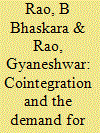|
|
|
Sort Order |
|
|
|
Items / Page
|
|
|
|
|
|
|
| Srl | Item |
| 1 |
ID:
091566


|
|
|
|
|
| Publication |
2009.
|
| Summary/Abstract |
Since the early 1970s, there has been a worldwide upsurge in the price of energy and in particular of gasoline. Therefore, demand functions for energy and its components like gasoline have received much attention. However, since confidence in the estimated demand functions is important for use in policy and forecasting, following [Amarawickrama, H.A., Hunt, L.C., 2008. Electricity demand for Sri Lanka: A time series analysis. Energy Economics 33, 724-739], this paper estimates the demand for gasoline is estimated with five alternative time series techniques with data from Fiji. Estimates with these alternative techniques are very close, and thus increase our confidence in them. We found that gasoline demand is both price and income inelastic.
|
|
|
|
|
|
|
|
|
|
|
|
|
|
|
|
| 2 |
ID:
116708


|
|
|
|
|
| Publication |
2012.
|
| Summary/Abstract |
This article explains why: (a) consumers underinvest in new car fuel economy by opting to buy large vehicles; (b) macro shifts in vehicle classes have occurred in the last decades; and how (c) the effects of vehicle fuel economy and shifts in vehicle type influence the growth path of gasoline demand, which is the key to designing effective energy efficiency goals for transport. From 2008, 1.9 EXJ (Exajoules) of energy were consumed in Japan by private vehicles producing 124 MtCO2 emissions. For the period 1980 to 2008, we estimated: (1) gasoline demand for three vehicle sizes; (2) vehicle sales; (3) new car fuel economy changes (the 'real' technical change); and (4) vehicle stocks. Using a data sample for 1980-2008 we found that: (a) in the short term consumers buy fuel economy, that is sales of mini and small cars increase, but this is not sustained in the long term: and (b) consumers increasingly traded in their cars for larger cars. A further finding was that gasoline demand is projected to increase to 2.3 EXJ by 2035, even with a growing number of mini cars. The policy implication is clear: Japan's policy to reduce oil dependency to 80% by 2030 is in peril as long as buyers prefer larger cars and drive ever longer distances.
|
|
|
|
|
|
|
|
|
|
|
|
|
|
|
|
| 3 |
ID:
126549


|
|
|
|
|
| Publication |
2013.
|
| Summary/Abstract |
Using cointegration techniques, we investigate the determinants of gasoline demand in Switzerland over the period 1970-2008. We obtain a very weak price elasticity of -0.09 in the short run and -0.34 in the long run. For fuel demand, i.e. gasoline plus diesel, the corresponding price elasticities are -0.08 and -0.27. Our rich dataset allows working with quarterly data and with more explicative variables than usual in this literature. In addition to the traditional price and income variables, we account for variables like vehicle stocks, fuel prices in neighbouring countries, oil shocks and fuel taxes. All of these additional variables are found to be significant determinants of demand.
|
|
|
|
|
|
|
|
|
|
|
|
|
|
|
|
| 4 |
ID:
111315


|
|
|
|
|
| Publication |
2012.
|
| Summary/Abstract |
We generally consider that the price elasticity of the energy demand is quite small. But it appears that strong increases in gasoline price lead to modifications in consumer behaviors. The high volatility of petroleum prices and the strong increases since the beginning of 2000 justify an analysis of price effects on gasoline consumption. We estimate the effects of price variations on gasoline consumption, in the United States and India. We use a co-integration modelling to test for long-run relationship between gasoline consumption, income, price and vehicle ownership in the two countries. We use an error correction model to test for short-run prices effects and more precisely for asymmetric effects on demand of increases and decreases in gasoline prices. The main conclusions are the following. Concerning the United States, the long-term price elasticity is relatively high for an industrialised country because gasoline taxes are low, but we show that households are more sensitive to a price increase than a price decrease. About India, price elasticity in the long-run is quite high but is quite small in the short-run. It is not surprising for an emergent country. It seems that there is no asymmetric effect of price variations on gasoline consumption.
|
|
|
|
|
|
|
|
|
|
|
|
|
|
|
|
| 5 |
ID:
112893


|
|
|
|
|
| Publication |
2012.
|
| Summary/Abstract |
We empirically estimate the demand for gasoline in the presence of multiple shifts caused by structural breaks using monthly data from Lebanon covering the period 2000:M1-2010:M12. Consistent with most studies in the literature, our study reports that gasoline is price and income inelastic in the short-run. However, when a single and multiple breaks are introduced, the consumers' responsiveness to gasoline price and income increase. Since both price and income elasticity are sensitive to structural changes, a policy that pleads for a flat excise tax may not be optimal with respect to either the cyclical pattern of government revenues or the internalization of international environment standards.
|
|
|
|
|
|
|
|
|
|
|
|
|
|
|
|
|
|
|
|
|